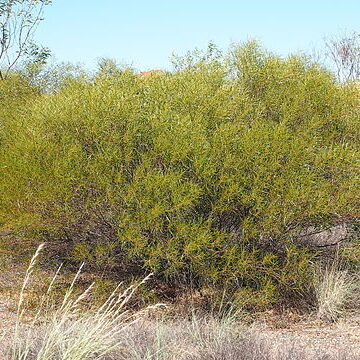Fastigiate, multi-stemmed shrub 1.5–4 m high. Bark grey, longitudinally fissured towards base of mature stems otherwise smooth. Branchlets angular, often flexuose, pale yellowish orange or red-brown, glabrous. Phyllodes linear, or very narrowly elliptic, straight or slightly falcate, (4.5–) 6–18 cm long, (2–) 3–10 (–13) mm wide, coriaceous, somewhat shiny, bright olive-green, glabrous, with 1–3 subprominent yellowish main veins; minor inconspicuous veins 3 or 4 per mm, with rare anastamoses; marginal vein discrete and yellowish; glands inconspicuous, 2 or 3, marginal. Spikes 2.5–4.5 cm long, golden; peduncles 5–15 (–25) mm long. Flowers 5-merous; calyx 0.5–0.8 mm long, dissected to ⅓, glabrous or slightly tomentose; corolla 1.5–1.8 mm long, dissected to ½ its length, glabrous; ovary ±tomentose. Pods narrowly oblong or cultrate, tapered at both ends with apex ± hooked, slightly indented or straight-sided, 6–11.5 cm long, often erect, crustaceous to subwoody, obliquely reticulate, brown to dark brown, glabrous, resinous, dehiscing elastically (valves recurved following dehiscence); seed-partitions well marked; marginal vein thick. Seeds oblique, broadly oblong to ± oblong-elliptic or ± ovate, 6–7 mm long, brownish black; pleurogram fine, with yellowish halo (outer band pitted); areole open, depressed.
More
A tall slender shrub. It grows 1-3 m high. The young shoots are sticky and pale coloured. The leaves (phyllodes) are long and thin. They are 8-18 cm long by 0.3-0.5 cm wide. They are bright green and shiny. Along their length they have one clear vein. The flower heads are like rods and 1.5 to 2 cm long. They are bright yellow and on short stalks. The pods are long (5-7.5 cm) and thin (0.5-1.2 cm). The end of the pod is hooked like a fish hook. The pods are leathery and with a wavy edge.
Grows usually in mallee-spinifex communities and in stony spinifex grasslands, and in shrub-steppes and along watercourses, in deep red sands and skeletal soils on lateritic plains; at elevations up to 500 metres.
More
Grows usually in mallee-spinifex communities and in stony spinifex grasslands, and in shrub-steppes and along watercourses, in deep red sands and skeletal soils on lateritic plains.
It is a tropical plant. It needs a well drained soil and a sunny position. It suits semiarid locations.


